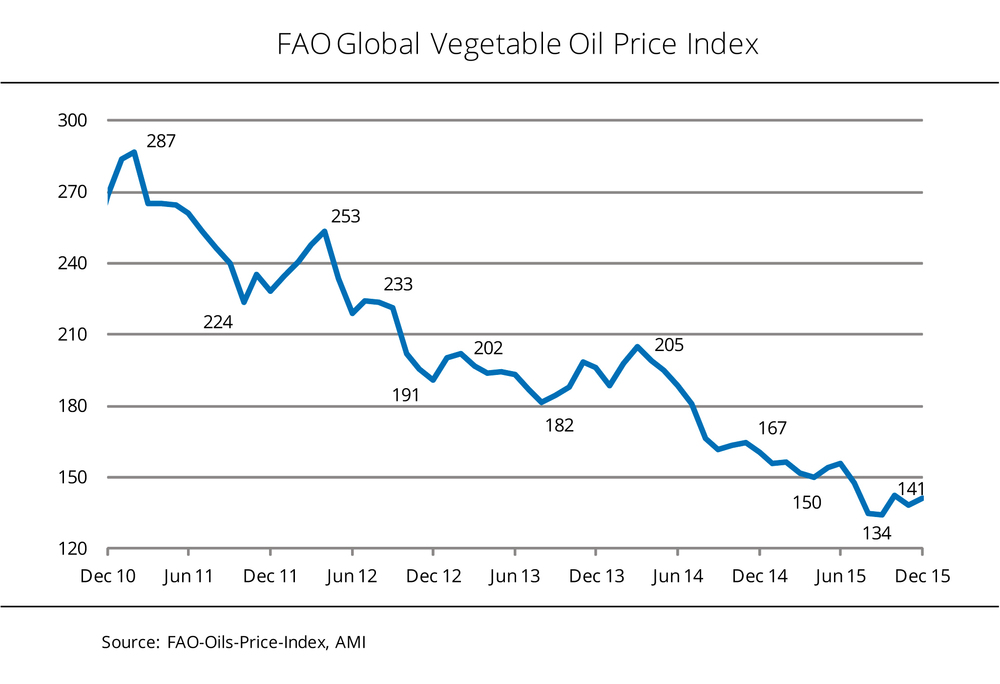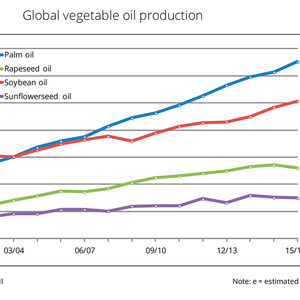Soy processing grows as vegetable oil prices remain at record low



January 22, 2016
BY UFOP
Global soybean oil production has risen approximately 5 percent, based on the 2015-’16 record supply of feedstock. By contrast, production of rapeseed oil has declined from the previous year. Smaller and, consequently, more expensive feedstock supply increases competition with other oils.
The nosedive of mineral oil prices has put a heavy damper on demand for vegetable oils. Biodiesel based on vegetable oils can currently hardly compete with mineral diesel, Agrarmarkt Informations-Gesellschaft mbH (AMI) reports. But there is hope. OPEC expects crude oil prices to surge again over the next few years in the wake of rising costs. Nevertheless, 2015-’16 global output of vegetable oils rises by just under 2 percent, to 179 million tons. At the same time, soybean oil production increasingly converges with that of palm oil, the world’s leading vegetable oil. Production of rapeseed oil falls for the first time in nine years, but continues to exceed the long-term mean. Production of sunflower oil stagnates.
In December, the vegetable oil price index of the Food and Agriculture Organization of the United Nations rose by almost 2 percent, but continues at a nine-year low even though biodiesel production has increased.
Advertisement
The downward slide came to a halt in December as soybean oil prices surged, hitting a six-month high. At the same time, prices for palm were stable. Continued fears that the weather could have a negative impact on crop output in Southeast Asia had offset slow demand, AMI reported. Nevertheless, at 141 points, the December index was one-fifth below the previous year’s level. The FAO price index measures the changes in international prices for 10 different vegetable oils, weighted with their shares in world trade.
Advertisement
Related Stories
The USDA significantly increased its estimate for 2025-’26 soybean oil use in biofuel production in its latest World Agricultural Supply and Demand Estimates report, released July 11. The outlook for soybean production was revised down.
U.S. fuel ethanol capacity fell slightly in April, while biodiesel and renewable diesel capacity held steady, according to data released by the U.S. EIA on June 30. Feedstock consumption was down when compared to the previous month.
The U.S. EPA on July 8 hosted virtual public hearing to gather input on the agency’s recently released proposed rule to set 2026 and 2027 RFS RVOs. Members of the biofuel industry were among those to offer testimony during the event.
The USDA’s Risk Management Agency is implementing multiple changes to the Camelina pilot insurance program for the 2026 and succeeding crop years. The changes will expand coverage options and provide greater flexibility for producers.
The USDA’s National Agricultural Statistics Service on June 30 released its annual Acreage report, estimating that 83.4 million acres of soybeans have been planted in the U.S. this year, down 4% when compared to 2024.
Upcoming Events










